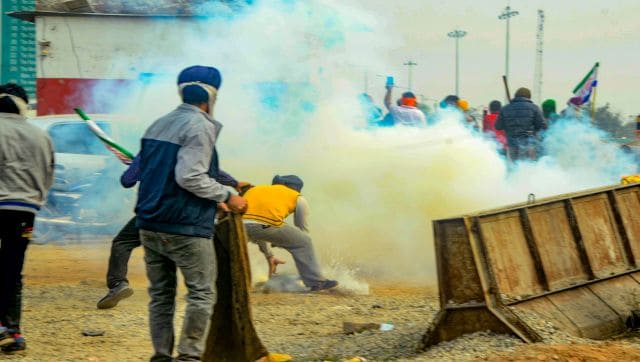How drones air-dropped tear gas on protesting farmers at Shambhu border

Police use tear gas shells to disperse farmers gathered at Punjab-Haryana Shambhu border for their ‘Delhi Chalo’ march, near Patiala. Farmers later said that 60 of them had been injured in the tear gas shelling. PTI
On Tuesday (13 February), disturbing scenes emerged at the Shambhu border point between Punjab and Haryana when authorities fired tear gas at the farmers, who were participating in the ‘Delhi Chalo’ march.
Visuals from the scene showed thick clouds of tear gas, as police sought to disperse the protesting farmers near Ambala and Jind in the Haryana region. Following the release of the tear gas smoke, farmers were seen carrying wet jute bags to shield themselves from the effect of the smoke.
The use of force and tear gas against the farmers were condemned by many with Uttar Pradesh Congress leader Pankhuri Pathak terming it a “shameful act” towards citizens in a democracy. “These tear gas shells are being fired at the food providers of the country. Their demand is that they should get the right price for their crops. Is this demand such that the government should use such force on Indian citizens? Such atrocities on citizens in a democracy are shameful!” Pathak said in a post in Hindi on X.
Related Articles
Notably, the tear gas shells launched at the protesting farmers on Tuesday were deployed from drones — the first time that the police force in India has used drones to launch tear gas devices.
Here’s what we know about them and how they were used during the farmers’ protest.
Drones dropping teargas shells
The Haryana Police on Tuesday deployed drones made by Drone Imaging and Information Service of Haryana Limited (DRIISHYA), a public limited company incorporated in 2021. These drones, according the government, are designed for “surveying infrastructure projects, monitoring of agriculture and horticulture crops, and surveillance of sensitive areas for security purposes.”
According to reports, the drone-based tear smoke launcher was developed by the Tear Smoke Unit (TSU) of the Border Security Force (BSF) in 2022 and was introduced during the 42nd Governing Body meeting. At that time, authorities had displayed how the project could be used as potential force multiplier to enforce law and order.

Officials also said that unlike guns that need to manually loaded with smoke gas shells, these drones can drop multiple grenades. “The drones are capable of firing several munitions at one go and the launch is controlled by a remote,” an official was quoted as telling Indian Express.
Moreover, the teargas firing gun has a limited range. But the drones can cover 400-500 metres and even beyond.
And how do they work? Tear smoke shells are placed tightly in a metal cage fixed under a hexacopter drone. The drone system, operated remotely, then drops the tear shell from the air at the designated spot.
Importantly, these drones, until now, have been used to blind terrorists at the borders during specific operations.
Tear gas lobbed at farmers
Thousands of farmers were making their way towards the National Capital when the personnel from the Haryana Police used tear gas to disperse the protesters at the Punjab-Haryana border. The farmers’ unions said around 100 farmers were injured during the day in the violence that broke out.
Initially, the Punjab Police allowed the farmers to cross the Rajpura bypass as they headed towards Haryana’s Ambala en route to Delhi. However, tensions rose at the Punjab-Haryana Shambhu border as protesting farmers attempted to break cement barricades with their tractors.

As farmers attempted to breach the tight security measures, the authorities brought in the drones firing tear gas shells. Later, farmer leader Sarwan Singh Pandher told news agency PTI, “In the history of India, today is a black day. It is shameful the way the Modi government attacked farmers and farm labourers.”
Jagjit Singh Dallewal, another farmer leader, also claimed that around 60 young farmers were injured in the police action. “Today, farmers wanted to go to the national capital and carrying out such an attack on them… around 60 youths got injured,” claimed Dallewal, who represents Samyukta Kisan Mocha (Non-Political). He also accused the Centre of not showing any seriousness towards their demands.
What comes next
After calling for a ‘ceasefire’ on their march on Tuesday night, farmers are poised to resume their march toward Delhi on Wednesday morning. As news agency PTI reported that the protesting farmers from Punjab will make a fresh attempt to break past the multiple layers of barricades at the border with Haryana in attempt to march to Delhi to press for various demands.

And in scenes reminding us of the 2020-21 protests, farmers say they are prepared for the long haul and are carrying rations worth six months — a sign that they are determined that their demands be met, no matter how long it takes.
Meanwhile, the Centre on Tuesday called for more talks. But farmers alleged that they are just wasting their time and have no intention of meeting their demands. Union Minister Anurag Thakur speaking on the same, said: “The Opposition parties are misguiding farmers on multiple issues against the NDA government but the farmers and issues pertaining to them are the top priority of the Modi government.”
He also farmers urged not to indulge in violence as it causes a “loss to the nation”, and also pointed out that thousands of common people were having to endure long traffic jams. He further reiterated the call for dialogue.
With inputs from agencies

Atul Tiwari is a seasoned journalist at Mumbai Times, specializing in city news, culture, and human-interest stories. With a knack for uncovering compelling narratives, Atul brings Mumbai’s vibrant spirit to life through his writing.







